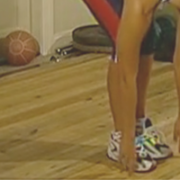Reflections on the Get Buffed!™ programs journey – origins, reactions and impact
It’s been 21 years (1999) since the first Get Buffed!™ program was released. A lot has happened in that time, and we have a lot to talk about! You can break this journey down into three periods – the origins, the reactions and the impact.
The program and its unique concept have changed the way the world trains, but it could do more. It has potentially underperformed, and I outline my thoughts about why I say that below.
The origins of the Get Buffed!™ program
The original Get Buffed!™ program was based on a lifetime of training and at the time in 1999, my prior 19 years of professional and experiences developing, testing, refining and reaching conclusion in the quest to optimize athlete performance.
There were many key influences in shaping the Get Buffed!™ program and I sought to credit and reference them where appropriate, an act that has lost relevance apparently post 2000.
Some of my key mentors included the local strongman on the island I grew up in the South Pacific Ocean, my high school teachers, my first ‘boss’ in the industry at the university I commenced at in 1980, my training partners in the weightlifting club I that I trained with during the ensuing decade.
Some of my influences included the few books available at the time, the magazines I was exposed to in the 1980s and 1990, and the strength athletes with the results to show. It was a different era – only those with obvious results would be promoted as role models, unlike the post 2000 era when individuals who lacked such personal success and commitment to their own training were given the platform via the internet to become strength training experts and authors.
The reaction to the Get Buffed!™ program
The world had not seen anything like the Get Buffed!™ program before, and the reaction was predictable – first it was ridiculed, then it was violently opposed, and then it became accepted as if everyone ‘always knew it’. Just as German philosopher Arthur Schopenhauer described new ‘truths’ are treated!
The ridicule was directed at many aspects of the program but for the most part the fact that it involved bodyweight exercises. No-one was integrating bodyweight exercises into heavy duty strength training programs and the appetite for the concept was low. The typical response was ‘how could you get big and strong doing just bodyweight?
To overcome this skepticism supporters wrote encouragement such as:
The following article is Part I of a two-part leg training article that’s very different from anything you’ve ever done. How so? Well, for starters, some of the exercises don’t even require you to use any weight beyond that of what you’ve got piled on top of your hip bones and dressed up in a Tommy Hilfiger shirt. Secondly, this workout has a nasty side effect. It hurts. Real bad.
Cast aside your skepticism and try the following workout this week. Part II will follow next week.[1]
Editor’s note: I tried Parts I and II of Ian’s workout this past week. It’s really unique, and I felt that I had blasted my legs. Of course, the most difficult part of the workout was shrugging off years of brainwashing. Doing exercises with little or no weight was a hard pill to swallow, but once I reminded myself that I didn’t care how different or weird the movements looked, I had a great workout. Remember, screw the pack mentality and give this workout a try! [2]
The next phase was violent opposition. It only took a year or so to get here, and it was led by those whose apple carts had been upturned by the concepts built into the program.
The guru that ran NY was incensed when his disciples told how I had suggested at a seminar in about 2000 in NYC that chin ups didn’t balance out bench pressing. This guru’s programs were totally devoid of horizontal pulling (e.g. rows) and this didn’t sit well. The immediate reactions included a banning of all that Guru’s disciplines from attending my seminars. Seminar attendance in North America was down by 50% as a result. The interim approach was to tell the disciples that if they ordered any of our educational material, when the parcel arrived, they would get arrested. Go figure!? He had his Lieutenants tell people I was about to be arrested! And the long-term play was the release of a ‘modified’ exercise that would ‘fix’ the problem without changing the exercise selection – so still no need to row…Learn exactly what that exercise was during the upcoming webinar.
New York was not the only push back experience. The Boston Guru had his own approach. Again, incensed at the content of a live seminar because it was very different to what he was doing, he arranged a mid-seminar walkout of his disciples and successfully intimidated the seminar host to never host my seminars again. But it was his long-term play that shocked me – learn about that in the upcoming seminar!
Then the final phase was characterized the trend spotters pumping out material that looked very ‘similar’. When questioned about the origin the typical response was ‘we are just going back to stuff that has always been around. For example, when teaching bodyweight exercises straight out of the Get Buffed!™ program, book and DVD, under the guise of ‘your body is a barbell’ a presenter in 2003 was asked:
Q. This is so perfect for me…I am very limited in what I could take. You say you steal everything, where did you steal this stuff from?
A. Um, God [looks up at heavens], I steal from a lot of people. Er, some stuff from Ian King. Um, a lot of stuff from Paul Chek. And just the older stuff, like when you go back and read like early training manuals, this stuff is nothing new, like we didn’t invent it, it’s just that its been forgotten about, so we are going back to get it….[3]
These early imitations were. then followed by the ‘functional training movement’, and I will address this at length in the upcoming webinar.
Suffice to say, it’s been the classic over-reaction I spoke about when I coined the saying:
One of my passions is the study of futurism and human behavior. As such I had developed a saying based upon this study, about how humans’ reaction to new ideas in the short and long term.[4]
It is also appropriate to remind you of the natural human and social reactions – an over-reaction in the short term and an under-reaction in the long term. When a ‘new’ thing becomes popular, many over-promote it and many over use it. [5]
And there you have the three stages, moved through in a matter of years. It was quick.
It was also really messed up, because those who were at the forefront of wanting to benefit from the acceptance of the concepts introduced in the Get Buffed!™ program didn’t have the connection with and the experience in the training methods, concepts and exercises. It was more about the benefit to them from being the message bringer than a desire to bring the message in its intended format. More insights into this during the upcoming webinar.
The longer term impact of Get Buffed!™ program
We have received unsolicited testimonials from so many about the positive impact of the Get Buffed!™ program, and that have been veery rewarding to know of this positive impact. However there has been another side to this impact.
In hindsight I realize that the concepts and innovations I shared with the release in 1999 of the Get Buffed!™ program had some longer-term impacts I failed to anticipate.
There is the opportunity to correct these impacts however they may never be fully removed.
To illustrate this point I will take about a few exercises and training concepts. I will discuss the origins of these and other unique exercises during the webinar.
The popularization of the Roman Deadlift, with its flat back, appears to have contributed to the demise of the traditional and more valuable bent knee deadlift. Post 2000, if you ask anyone – from industry professional to end user – to show you what a deadlift was, I found them demonstrating the flat back version. There are many other factors that have been involved, including the difficulty of teaching/learning the bent knee deadlift, and the injury risks associated with a poorly executed bent knee deadlift. However I believe that light that was shone on the flat-backed version aka the Romanian Deadlift was, tragically, a large contributor to this shift.
As a further side effect of this has been the sending of the round-back good morning to the sin bin, as popular as static stretching in the current paradigm environment. More on that in the webinar!
The single leg stiff legged deadlift was bastardized very quickly after release (more on that in the seminar) and the result has been nothing more than tragic. Because I get to travel the world and visit many training facilities, it’s been hurtful to see the embracing of this misinterpretation of this incredible exercise – which is more like a ballet move than what I had created. It may be too late to undo this mess, but we can help those committed to learning the intent and receiving the benefits!
The championing of the Bulgarian Squat has led to what I campaigned for so long to avoid and part of the driving force behind the Lines of Movement concept I developed (hip and quad, vertical and horizontal push and pull categorization – the over-training of the quad dominant muscle group. (Yes, that is what I said – the ‘quad dominant muscle group’! Not the ‘knee dominant’ exercises, and that’s a story we might get into in the webinar also!). A great exercise for sure, however when you give more sugar to a diabetic, it doesn’t end well…
The Lines of Movement concept was borne out of my observations of the trends in shape change in leading strength exponents, specifically bodybuilders. Not only have we failed to prevent the two key muscle/joint imbalances I sought to address through this concept, the promotion of unilateral work and the presentation of the concept of exercise classification has led to a tragic side-effect.
Uni-lateral exercise has been around forever, however it was not a focus or feature of western world training until the arrival of the Get Buffed!™ program. Exercise classification up until the release of the Get Buffed!™ program was limited to muscle groups.
For example, this is my leg day. No split between quad and hip dominant. This is my chest, shoulder, and triceps day. No recognition of planes of movement. The ‘Lines of Movement’ concept changed this.
However, the ongoing search for a better ‘mouse-trap’ by those seeking significance more than seeking to solve an existing problem, has let to new patterns of physical dysfunction that were non-existent in the 1980s, when I developed the exercise categorization of Lines of Movement. Two new dysfunction epidemics have evolved that I didn’t see coming, leaving the majority with now the ‘Big Four’ musculo-skeletal dysfunctions, and I will speak about them in the webinar.
That’s heartbreaking for me – to think that I introduced an exercise categorization concept to combat the ‘Big Two’ of the 1980s, only to responsible (indirectly) for the ‘Big Four’ decades later.
Conclusion
So there you have it – 21 years since the first Get Buffed!™ program was released and the journey since– the origin, the response and the longer term impact. Four Get Buffed books (the only four book sequel in this genre I am aware of) and thirteen DVDs later! And more to come…
Join the discussion on the upcoming webinar and training camp where we will take a deep dive into all things Get Buffed!™
Webinar Options
21 reflections on the journey – origins, response and impact of the Get Buffed!™ programs!
Celebrating 21 years of Get Buffed!™
Webinar Option 1 – Evening in the Americas, daytime in Asia Pacific
Webinar Option 2 – Evening in Asia Pacific, daytime in Europe
Join the upcoming Get Buffed! Training Camp
References
[1] TC Louma, 1999, in the introduction to my workout A in my unique bodyweight based strength and bodybuilding program, a pioneer program at that time, Editor T-mag.com, Sep 17 1999
[2] TC Louma, 1999,, in the conclusion to Workout B of my unique bodyweight based strength and bodybuilding program, a pioneer program at that time…., Editor T-mag.com, Sep 24 1999
[3] Cosgrove, A., 2003, Your body as a barbell – unconventional bodyweight exercises, DVD, 18 Oct 2003, at Charles Staley Bootcamp
[4] King, I., 2010, Barbells & Bullshit (Book), Chapter 3 – Those sayings look familiar?!, p. 13
[5] King, I., 2002, Heavy Metal Q & A, T-mag.com, 30 Oct







